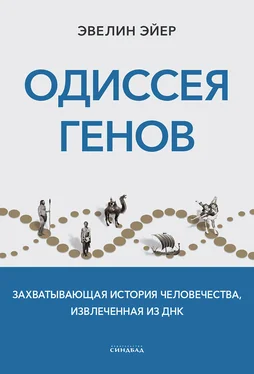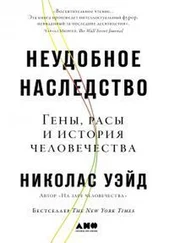Piel, F. B. et al ., 2010, «Global distribution of the sickle cell gene and geographical confirmation of the malaria hypothesis», Nature Communications , 1(8).
Posth, C. et al ., 2016, «Pleistocene mitochondrial genomes suggest a single major dispersal of non-Africans and a late glacial population turnover in Europe», Current Biology , 26(4), p. 557–561.
Quach, H. et al ., 2016, «Genetic adaptation and Neandertal admixture shaped the immune system of human populations», Cell , 167(3), p. 643–656.
Quillen, E. E. et al ., 2019, «Shades of complexity: New perspectives on the evolution and genetic architecture of human skin», American Journal of Physical Anthropology , 168, p. 4–26.
Raghavan, M. et al ., 2015, «POPULATION GENETICS. Genomic evidence for the Pleistocene and recent population history of Native Americans», Science , 349(6250).
Rasmussen, M. et al ., 2011, «An aboriginal Australian genome reveals separate human dispersals into Asia», Science , 334(6052), p. 94–98.
Rogers, A. R. et al ., 2004, «Genetic variation at the MC1R Locus and the time since loss of human body hair», Current Anthropology , 45(1), p. 105–108.
Roullier, C. et al ., 2013, «Historical collections reveal patterns of diffusion of sweet potato in Oceania obscured by modern plant movements and recombination», Proceedings of the National Academy of Sciences , 110(6), p. 2205–2210.
Schlebusch, C. M. et al ., 2012, «Genomic variation in seven Khoe-San groups reveals adaptation and complex African history», Science , 374(2012), p. 1–10.
Schlebusch, C. M. et al ., 2015, «Human adaptation to arsenic-rich environments», Molecular Biology and Evolution , 32(6), p. 1544–1555.
Schlebusch, C. M. et al ., 2018, «Tales of human migration, admixture, and selection in Africa», Annual Review of Genomics and Human Genetics , 19(1), p. 405–428.
Schlebusch, C. M. et al ., 2017, «Southern African ancient genomes estimate modern human divergence to 350,000 to 260,000 years ago», Science , 358(6363), p. 652–655.
Sikora, M. et al ., 2017, «Ancient genomes show social and reproductive behavior of early Upper Paleolithic foragers», 358(6363), p. 659–662.
Skoglund, P. et Mathieson, I., 2018, «Ancient human genomics: The first decade», Annual Review of Genomics and Human Genetics , 19(1), p. 381–404.
Skoglund, P. et al ., 2017, «Reconstructing prehistoric African population structure», Cell, 171(1), p. 59–71.
Slatkin, M. et Racimo, F., 2016, «Ancient DNA and human history», Proceedings of the National Academy of Sciences , 113(23), p. 6380–6387.
Smith, J. et al ., 2018, «Estimating time to the common ancestor for a beneficial allele», Molecular Biology and Evolution , 35(4), p. 1003–1017.
Tucci, S. et al ., 2018, «Evolutionary history and adaptation of a human pygmy population of Flores Island, Indonesia», Science , 361(6401), p. 511–516.
Veeramah, K. R. et Hammer, M. F., 2014, «The impact of whole-genome sequencing on the reconstruction of human population history», Nature Reviews Genetics , 15(3), p. 149–162.
Verdu, P., 2016, «African Pygmies», Current Biology , 26(1), p. R12–R14.
Verdu, P. et al ., 2009, «Origins and genetic diversity of pygmy hunter-gatherers from Western Central Africa», Current Biology , 19(4), p. 312–318.
Verdu, P. et al ., 2010, «Limited dispersal in mobile huntergatherer Baka Pygmies», Biology Letters, 6(6), p. 858–861.
Walsh, S. et al ., 2017, «Global skin colour prediction from DNA», Human Genetics , 136(7), p. 847–863.
Wilde, S. et al ., 2014, «Direct evidence for positive selection of skin, hair, and eye pigmentation in Europeans during the last 5,000 y», Proceedings of the National Academy of Sciences , 111(13), p. 4832–4837.
Wong, E. H. M. et al ., 2017, «Reconstructing genetic history of Siberian and Northeastern European populations», Genome Research , 27(1), p. 1–14.
Yang, M. A. et Fu, Q., 2018, «Insights into modern human prehistory using ancient genomes», Trends in Genetics , 34(3), p. 184–196.
Yang, M. A. et al ., 2017, «40,000-year-old individual from Asia provides insight into early population structure in Eurasia», Current Biology , 27(20), p. 3202–3208.
Yang, Z. et al ., 2016, «A genetic mechanism for convergent skin lightening during recent human evolution», Molecular Biology and Evolution , 33(5), p. 1177–1187.
Часть 3
Aimé, C. et al ., 2013, «Human genetic data reveal contrasting demographic patterns between sedentary and nomadic populations that predate the emergence of farming», Molecular Biology and Evolution , 30(12), p. 2629–2644.
Aimé, C. et al ., 2014, «Microsatellite data show recent demographic expansions in sedentary but not in nomadic human populations in Africa and Eurasia», European Journal of Human Genetics , 22(10), p. 1201.
Allentoft, M. E. et al ., 2015, «Population genomics of Bronze Age Eurasia», Nature , 522(7555), p. 167–172.
Bahuchet, S., 1991, «Spatial mobility and access to resources among the African Pygmies», in M. J. Casimir, A. Rao, Mobility and Territoriality: Social and Spatial Boundaries among Foragers, Fishers, Pastoralists and Peripatetics , Berg, p. 205–255.
Batini, C. et al ., 2015, «Large-scale recent expansion of European patrilineages shown by population resequencing», Nature Communications , 6.
Becker, N. S. A. et al ., 2012, «Short stature in African Pygmies is not explained by sexual selection», Evolution and Human Behavior , 33(6), p. 615–622.
Becker, N. S. A. et al ., 2011, «Indirect evidence for the genetic determination of short stature in African Pygmies», American Journal of Physical Anthropology , 145(3), p. 390–401.
Becker, N. S. A. et al ., 2013, «The role of GHR and IGF1 genes in the genetic determination of African Pygmies’ short stature», European Journal of Human Genetics , 21(6), p. 653.
Brites, D., 2015, «Co-evolution of Mycobacterium tuberculosis and Homo sapiens», Immunological reviews , 264(1), p. 6–24.
Broushaki, F. et al ., 2016, «Early Neolithic genomes from the eastern Fertile Crescent», Science , 7943, p. 1–16.
Chiang, C. W. K. et al ., 2018, «Genomic history of the Sardinian population», Nature Genetics , 50(10).
De Barros Damgaard, P. et al ., 2018, «137 ancient human genomes from across the Eurasian steppes», Nature , 557(7705).
De Barros Damgaard, P. et al ., 2018, «The first horse herders and the impact of early Bronze Age steppe expansions into Asia», Science , 360(6396).
Ermini, L. et al ., 2008, «Report complete mitochondrial genome sequence of the Tyrolean iceman», Current Biology , 18(21), p. 1687–1693.
Evershed, R. P. et al ., 2008, «Earliest date for milk use in the Near East and southeastern Europe linked to cattle herding», Nature , 455, p. 31–34.
Fan, S. et al ., 2016, «Going global by adapting local: Review of recent human adaptation», Science , 354(6308), p. 54–59.
Feldman, M. et al ., 2019, «Late Pleistocene human genome suggests a local origin for the first farmers of central Anatolia», Nature Communications , 10(1).
Читать дальше
Конец ознакомительного отрывка
Купить книгу












